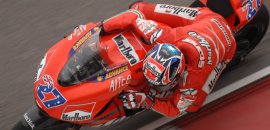ABSFrom TrackpediaABS or Anti-lock braking system, is a computer module governing braking pressure in the event of a drastic braking. The concept of the system is to avoid wheel lock-up therefore theortically decreasing braking distance, and also maintaining steerability and stability while braking, as well as allow for less wear on the tires. Early ABS systems (late 80's and early 90's) worked on one axle alone, or on all of the wheels, in one channel, simulating human cadence braking. The system would detect when one of the four wheels locked-up and, after it was locked, would release all four tires nearly completly, and reapply in a rate similar to human pedal pumping. This, in turn, was highly inefficient, and resulted in exaggeratedly increased distances, crippled steerability and stability. Furthermore, it did not nessecary manage to keep the wheels unlocked when surfaces were slippery or when grip was split (braking on two surfaces). Newer ABS systems, like which we have in many cars to date (end of the 90's, up to 2005 or so), have four, or at least three channels, thus being able to monitor each wheel individually, or each of the front wheels and both rear-wheels as one (3-channel ABS). Also, they do not release the locked-wheels all together, but monitor pressure to lock and unlock them, without releasing all of the braking pressure. However, in spite of the fact that these cars are able to remain nearly perfectly stable and sufficient steerable in every condition, they actually still stop slightly (just slightly) further than locked-wheels when on high-traction tarmac. However, they do make the braking distance significantly shorter in slippery conditions. A problem of these systems is their very noticeable activity: At work, these systems can create pulsation to the brake pedal, juddering of the steering wheel and chassis, and laud noises. This is particularly noticeable on the wet, where the system works harder. However, this is natural, helps in braking, and actually makes braking more technically friendly to the car's components in general. Latest ABS systems, are able to perform in great proximity to threshold braking, being able to completely avoid wheel lock-up, keep the car braking at the threshold for most of the time, and stop it quicker on almost any surface. This ABS system does not mimic cadence braking, like many people believe (which held true for the older systems). The one place where ABS (and threshold braking) carry increased braking distances, is on soft surfaces, typically soft gravel, and sometimes even a bit of fresh snow. However, ABS or threshold braking, still enable steerability and stability. In the latest systems, however, the advantage of steerability and stability is decreased in sake of a shorter braking distance. This can be seen, if braking on split-grip. Additionally, with all ABS systems, steerability is crippled somewhat, and should be issued carefully and accurately. Regardless of the type of ABS fitted (if at all), it is suggested that, in relation to braking before a corner on the track, that you use threshold braking with a regressive approach: Apply the foot-brake rapidly, but not quite stomping on it at once, untill the thershold where ABS is about to kick-in or when the wheels are about to lock-up. Now, gradually modulate the pressure (generally this means constantly and controllably releasing pressure as you go), to keep the car at threshold braking. This will slow you down more efficiently. However, an emergency is approached differently, even for professionals, the advice is to immediately stomp the brakes, and let the ABS or locked-wheels slow you down to a halt. Even without ABS, modern cars tend to remain highly stable, because the inertia is pushing them dead ahead. A normal phenomenon is for the car to rotate slightly (typically no more than 45 degrees) around it's own axle, making it look as though if it is swerving or about to spin. However, regardless of the amount of rotation (which should be minimal, even on slippery or split grip conditions), the car would keep on going straight forward. In this context it should be mentioned that ABS commercials tend to display these physical issues as problems. In these commercials, cars without ABS are made to brake significantly further away, or rotate far more than they should (80 degrees, 360 or even ten spins). This is caused by playing around with tire pressures, or by using special skid-pans, sometimes presented as merely wet surfaces, but actually include a white line made of a highly slippery surface (similar to ice) thus simulating a condition of split-grip, which is far more acute than any realistic situation. Normally, split-grip braking in emergencies is done with two wheels on a gravel or grassy shoulder, or on a slightly more frozen or wet part of the road. In the Bosch commercial, for an example, one car is made to stop dramatically further away, when without ABS in the event of braking from a speed of 100km/h (approximately 90mph), and also rotates about 80 degrees. However, all other demonstrations done in that commercial, both cars stopped in similar distances and completely pitched forward, although those experiments were done in the wet. Only the final experiment, the skidpan, made the none-ABS car lose stability, but it ended up pitched forward just like the ABS car, and in the same distance. Mind you, the change in grip levels on that skid are extreme! The tarmac on such a test pan, with a good car and tires, are very high. The grip on the skidpad with normal tarmac tires are lower than those of smooth ice! In all of the following, a none-ABS car maintained stability and roughly maintained a straight line:
|
